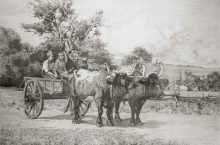John Carleton Wiggins
John Carletton Wiggins, often also going by just Carleton, was born in 1848 in Harriman, New York. In his youth, his artistic aspirations were already being cultivated and supported by his family. His art education was funded by a wealthy patron who saw promise in his early works, eventually sending Carleton to study in New York City at the National Academy of Design, under the tutelage of landscape painter George Inness. Prove successful there, his first exhibition held at the school was in 1870. Beginning his travels, he set his sight towards Europe, much like other young artists at the time, favoring the countryside and vast greenery as his muse. Eventually, he ended up in Paris studying the plein-air painting technique at a Salon, inspiring him to paint in the environment that he was depicting, rather than staying within the confines of his studio. From this he began adding in different kinds of cattle and animals to his works, after seeing the success of his new addition he displayed his new work at various Salons in the city. Though preferring to study and practice exclusively in Europe, he maintained a residence in Old Lyme, Connecticut. He is noted to have been one of the founders of the American Impressionism movement at the Old Lyme Art Colony. Known to this day as one of the most prolific painters of sheep and cattle in the United States, his legacy was upheld by his children who went on to pursue the arts as well, most notable his son Guy Carleton Wiggins who found success as a painter of American skylines. Carleton passed away in Old Lyme, Connecticut on June 11th, 1932.
